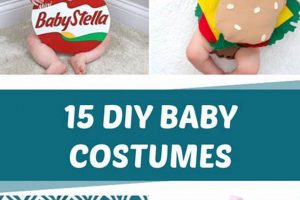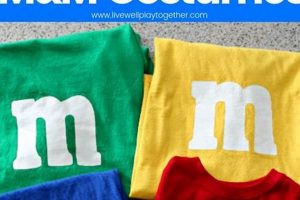The creation of individualized Polynesian-inspired attire involves constructing or assembling garments and accessories that evoke the spirit of Hawaiian culture. This often includes crafting skirts from materials like raffia or fabric, designing leis from artificial or natural flowers, and selecting tops or swimwear that complement the overall aesthetic. The resulting ensemble aims to capture the essence of traditional Hawaiian dress in a personalized and often cost-effective manner.
Engaging in the production of self-made island-themed clothing promotes creativity and resourcefulness. It allows for customization based on individual preferences and body types, leading to a unique and comfortable outfit. Furthermore, this approach can be economically advantageous, particularly for events such as luaus or themed parties, offering a budget-friendly alternative to purchasing pre-made options. The practice also connects individuals with elements of Hawaiian tradition, albeit often in an adapted and modernized form.
The subsequent sections will explore specific techniques for constructing key components of such attire, including methods for crafting skirts, designing floral adornments, and sourcing appropriate supplementary items, providing detailed instructions and material recommendations.
DIY Hawaiian Costume
Creating convincing Polynesian-inspired attire requires attention to detail and careful consideration of materials. These guidelines offer practical advice for producing a respectable and durable homemade version.
Tip 1: Material Selection for Skirts: Opt for natural fibers such as raffia or durable synthetic alternatives like burlap. Consider the weight and drape of the material; heavier materials will provide a more substantial skirt, while lighter options offer better movement.
Tip 2: Secure Waistband Construction: Employ a sturdy elastic band or woven cord for the skirt waistband. Ensure the band is appropriately sized and securely attached to the skirt material to prevent slippage during wear.
Tip 3: Floral Adornment Longevity: When creating leis or headbands, use artificial flowers for increased durability and reusability. If natural flowers are preferred, select varieties known for their longevity and consider using floral preservatives.
Tip 4: Color Palette Considerations: While vibrant colors are common, research traditional Hawaiian colors and patterns for a more authentic representation. Earth tones and natural greens can provide a sophisticated and respectful aesthetic.
Tip 5: Closure Security: For tops or garments requiring closures, use strong buttons, snaps, or hook-and-eye fasteners. Reinforce these closures with additional stitching to prevent wardrobe malfunctions.
Tip 6: Proper Fit Assessment: Prior to final assembly, conduct thorough fit tests of each component. Adjustments should be made to ensure comfort and proper coverage, especially when adapting existing garments.
Tip 7: Proportional Considerations: Ensure that the proportions of the skirt, top, and accessories are visually balanced. Overly long skirts or excessively large floral arrangements can appear disproportionate and detract from the overall aesthetic.
Adhering to these tips will result in a more robust and aesthetically pleasing result. These considerations improve the durability and visual impact of any homemade Polynesian-themed attire.
The subsequent section will address ethical sourcing and cultural sensitivity when engaging in the creation of such clothing, emphasizing responsible representation.
1. Material Selection
The selection of materials fundamentally dictates the authenticity, durability, and overall aesthetic of any self-constructed island-themed attire. In the context of a “diy hawaiian costume,” material choice influences not only the visual representation but also the wearer’s comfort and the garment’s longevity. For example, a skirt constructed from natural raffia will offer a more traditional appearance and texture compared to one made from synthetic alternatives. Similarly, choosing breathable fabrics for tops and linings is crucial for comfort, especially in warmer climates. Neglecting appropriate material consideration can result in a costume that appears inauthentic or is uncomfortable to wear.
Practical application of informed material selection extends beyond mere aesthetics. Opting for durable fabrics like canvas or reinforced cotton for structural elements such as waistbands ensures the costume can withstand repeated use. The selection of appropriate floral components whether artificial or natural also impacts the longevity of accessories like leis and headbands. Furthermore, understanding the properties of different materials allows for effective customization; for instance, lighter fabrics can be dyed or painted to achieve specific color palettes or patterns, thereby enhancing the personalized nature of the endeavor.
In summary, material selection is not simply a preliminary step but an integral component in the creation of a respectable and lasting self-made island-themed ensemble. It influences both the visual fidelity to traditional aesthetics and the practical aspects of comfort and durability. Prioritizing informed material choices addresses potential challenges in construction and ensures the final product aligns with the intended goals of authenticity, comfort, and longevity.
2. Skillful Construction
Skillful construction is paramount to the success of any attempt to create personalized Polynesian-inspired attire. This encompasses not only the technical aspects of sewing and assembling materials but also an understanding of garment structure and appropriate techniques for achieving a desired aesthetic and functional outcome.
- Pattern Adaptation and Modification
Successful adaptation of existing patterns is crucial. This might involve altering pattern sizes to accommodate individual measurements or modifying designs to better reflect traditional Hawaiian garment styles. Poorly adapted patterns can lead to ill-fitting or structurally unsound garments. For instance, a skirt pattern intended for a different fabric might need adjustments to account for the drape and weight of raffia.
- Seam Construction and Reinforcement
The choice of seam construction techniques directly impacts the durability of the finished product. Reinforcing stress points, such as the waistband of a skirt or the closures of a top, is essential. Improperly constructed seams are prone to unraveling or tearing, rendering the costume unwearable. Techniques like French seams or reinforced stitching can significantly extend the garment’s lifespan.
- Material Handling and Manipulation
Different materials require specific handling techniques. Raffia, for example, re
quires careful cutting and securing to prevent fraying, whereas fabric may need pre-treatment to prevent shrinkage or color bleeding. Improper handling can result in a visually unappealing or structurally weak garment. For instance, failing to properly finish the edges of a raffia skirt can lead to excessive shedding and a ragged appearance. - Finishing Techniques and Detailing
Proper finishing techniques, such as hemming and edge binding, are critical for achieving a professional look. Detailing, including the addition of embellishments like appliques or trims, enhances the visual appeal and personalization of the costume. Neglecting finishing techniques results in a poorly constructed garment that lacks polish. Securely attaching floral embellishments, for example, is essential to ensure they remain intact throughout wear.
These facets of skillful construction underscore the importance of technical proficiency and attention to detail in the creation of successful and aesthetically pleasing homemade island-themed attire. Mastery of these elements elevates the finished product beyond a mere assemblage of materials, resulting in a durable, well-fitting, and visually compelling representation.
3. Cultural Sensitivity
The act of creating individualized Polynesian-inspired attire carries an inherent responsibility to engage with Hawaiian culture respectfully. A lack of cultural sensitivity in costume creation can lead to misrepresentation, appropriation, and the perpetuation of harmful stereotypes. The intended outcome, to create a costume, becomes secondary to the potential negative impact on a living culture. For instance, using sacred symbols or designs without understanding their meaning is a direct offense. Choosing generic “tropical” elements rather than researching specific Hawaiian motifs diminishes the richness and complexity of the culture. Ignoring proper protocols, such as the appropriate wearing of lei, can demonstrate a lack of respect for the traditions associated with these items.
Practical application of cultural sensitivity involves thorough research into Hawaiian traditions, symbols, and protocols. This research should inform every aspect of the costume’s design and construction, from the materials used to the specific patterns and embellishments incorporated. Seeking guidance from Hawaiian cultural practitioners or consulting with cultural organizations is advisable. For example, understanding the specific occasions and protocols associated with wearing a lei is crucial. Furthermore, recognizing that certain designs are restricted or hold specific cultural significance prevents unintentional misuse. The costumed person should also avoid exaggerating or caricaturing Hawaiian features or mannerisms, as this perpetuates harmful stereotypes.
In summary, creating Polynesian-inspired attire demands conscious consideration of cultural sensitivity. Prioritizing respect for Hawaiian traditions over mere aesthetic imitation is essential. Challenges exist in accurately representing a culture from an outside perspective, emphasizing the need for ongoing learning and self-reflection. Adhering to these principles helps to ensure that the creation and wearing of such attire becomes an act of appreciation rather than appropriation, thus contributing to a broader understanding and respect for Hawaiian culture.
4. Accessorizing Appropriately
The careful selection and application of supplementary items significantly contribute to the overall effectiveness of a self-constructed Polynesian-inspired ensemble. In the context of a “diy hawaiian costume,” accessories serve not merely as ornamentation but as integral components that enhance the authenticity and visual impact of the finished attire. The omission of appropriate accessories, or the selection of items that clash with the overall theme, diminishes the costume’s credibility and can even undermine the wearer’s intended representation. A raffia skirt, for example, will appear incomplete without a complementary lei or head adornment. Conversely, excessively ornate or mismatched accessories can create a discordant and inauthentic impression.
Practical applications of appropriate accessorizing include the mindful selection of floral adornments, jewelry, and footwear. Leis, constructed from either artificial or natural flowers, should complement the color palette of the costume and be worn in a manner consistent with traditional Hawaiian customs. Jewelry, such as shell necklaces or bracelets, should be chosen to enhance rather than detract from the overall aesthetic. Footwear should be practical and appropriate for the intended setting, ranging from simple sandals to bare feet. The key lies in achieving a harmonious balance between the various elements, ensuring that each accessory contributes to a cohesive and authentic representation.
Appropriate accessorizing involves a careful balance between authenticity, functionality, and personal expression. Challenges exist in navigating the diverse range of accessory options and selecting items that align with both traditional Hawaiian aesthetics and individual preferences. However, by prioritizing mindful selection and thoughtful integration, individuals can enhance the visual impact and cultural sensitivity of their self-made island-themed attire, ultimately creating a more compelling and respectful representation. This process strengthens the overall impact of the costume.
5. Cost Management
Effective cost management is a critical consideration when undertaking the construction of personalized Polynesian-inspired attire. The ability to create such clothing while adhering to a predetermined budget allows for accessibility and creative expression without incurring excessive expenses. This section outlines key facets of cost management in the context of a self-made island-themed ensemble.
- Material Sourcing and Substitution
Strategic sourcing of materials is fundamental to minimizing expenses. This includes exploring discount fabric stores, utilizing coupons, and considering repurposed or recycled materials. For example, opting for inexpensive muslin fabric for the skirt lining or substituting natural raffia with synthetic alternatives can significantly reduce overall costs. The implications of such substitutions should be carefully considered, balancing cost savings with the desired aesthetic and durability.
- Repurposing and Upcycling Existing Items
Transforming existing clothing or materials into components of the Polynesian-inspired attire offers a cost-effective approach. Old t-shirts can be repurposed into tops, and discarded fabrics can be used to create floral embellishments or skirt overlays. This method not only reduces material costs but also promotes sustainability and creative resourcefulness. An example of this would be using an old brown tablecloth and cut it into skirt for a Hawaiian costume.
- Simplifying Design and Construction
Complex designs often necessitate specialized materials and advanced construction techniques, leading to increased costs. Simplifying the costume’s design and opting for basic construction
methods can mitigate these expenses. For example, choosing a simple straight skirt pattern over a more elaborate tiered design reduces both material requirements and labor time. A person can make the costume more creative instead for complex. - Bulk Purchasing and Resource Sharing
Purchasing materials in bulk, particularly when working on multiple costumes or collaborating with others, can yield significant cost savings. Similarly, sharing resources such as sewing machines, patterns, and tools among individuals reduces individual expenses. This collaborative approach fosters a sense of community and promotes efficient resource utilization.
These components of cost management demonstrate that the creation of personalized Polynesian-inspired attire can be both accessible and budget-friendly. By prioritizing strategic sourcing, repurposing, simplification, and collaboration, individuals can effectively manage expenses without compromising the aesthetic or functional integrity of the finished product. This reinforces the concept that creative expression and cultural appreciation can be achieved responsibly and affordably.
Frequently Asked Questions
This section addresses common inquiries regarding the creation of individualized Polynesian-inspired attire. The intent is to provide concise and informative answers to frequently encountered concerns or misconceptions.
Question 1: What constitutes appropriate material for a self-made Polynesian-inspired skirt?
Acceptable materials range from natural raffia to synthetic alternatives such as burlap or heavy cotton fabrics. Selection should prioritize durability, draping quality, and adherence to a desired aesthetic. Lighter fabrics are suitable for movement, while heavier options give the skirt more weight.
Question 2: How does one ensure cultural sensitivity when designing a Hawaiian-themed ensemble?
Cultural sensitivity requires diligent research into Hawaiian traditions, motifs, and protocols. Avoid appropriating sacred symbols or designs without understanding their significance. When in doubt, consulting with cultural experts or organizations is advisable.
Question 3: What are the most effective methods for securing floral embellishments to a self-made lei or head adornment?
Artificial flowers should be attached using sturdy glue or by wiring them securely to a base. Natural flowers can be strung together using thread or cord, though their lifespan is limited. Preservation techniques may extend the viability of natural floral arrangements.
Question 4: How can the cost of creating individualized Polynesian-inspired attire be effectively managed?
Cost management strategies include strategic material sourcing, repurposing existing items, simplifying designs, and bulk purchasing or resource sharing. A balance must be struck between cost savings and the desired quality and aesthetic of the finished product.
Question 5: What are the essential construction techniques for ensuring the durability of a self-made Hawaiian-themed garment?
Durable construction necessitates reinforced seams, secure closures, and appropriate material handling. Stress points, such as waistbands and closures, should be reinforced with additional stitching. Material edges should be properly finished to prevent fraying or unraveling.
Question 6: How can the fit of a self-made Polynesian-inspired garment be accurately assessed and adjusted?
Accurate fit assessment involves conducting thorough fit tests during the construction process. Adjustments should be made to ensure comfort, proper coverage, and appropriate proportions. Adapting existing patterns to individual measurements is also critical.
These answers provide a foundation for navigating the creation of individualized Polynesian-inspired attire. Additional considerations regarding specific design choices and individual preferences may arise during the construction process.
The following section will provide a conclusion to the document.
Conclusion
This exploration of the practice of crafting individualized Polynesian-inspired attire has underscored key aspects ranging from material selection and construction techniques to cultural sensitivity and cost management. The process involves a commitment to understanding both the technical skills required for garment creation and the cultural context that informs the aesthetic. Effective engagement necessitates informed decision-making at each stage, from initial design to final assembly.
The creation of a “diy hawaiian costume” therefore represents more than a mere exercise in crafting; it is an opportunity to engage responsibly with a cultural tradition. Prospective creators are encouraged to approach this endeavor with diligence and respect, seeking to produce attire that reflects both individual creativity and a thoughtful awareness of cultural significance. The result can be a respectful, visually appealing, and cost-effective garment.







